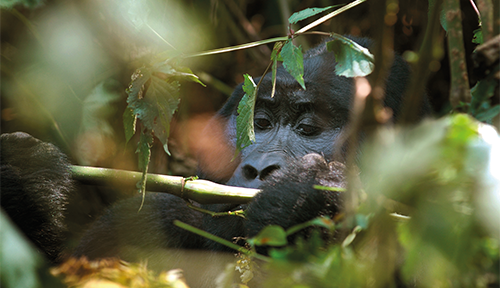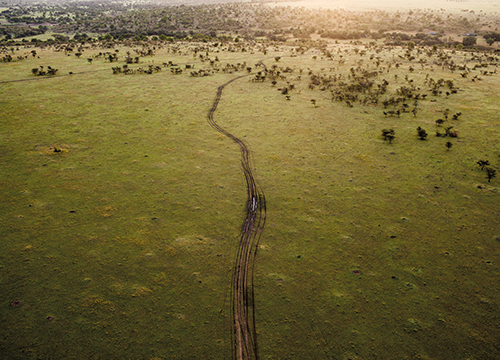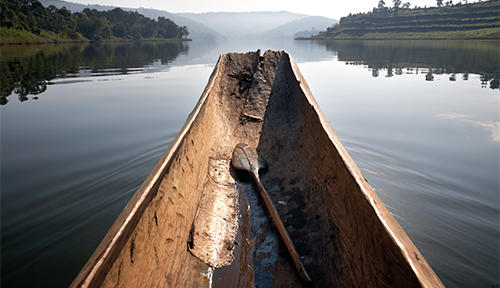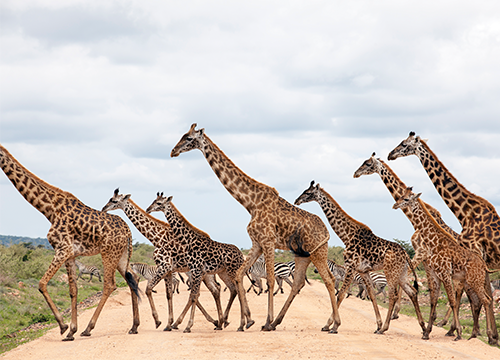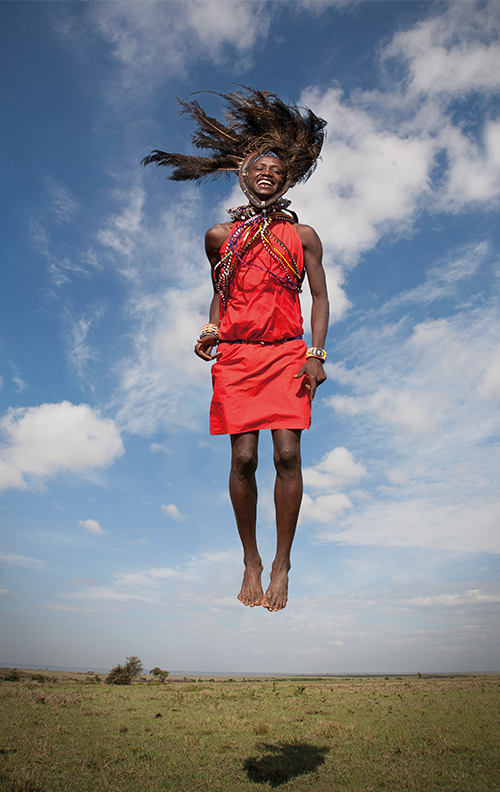Who cares about age or worries about the unknown? Not Di Brown, who headed off on an East African adventure to find elusive mountain gorillas, and a whole lot more
I am a 53-year-old, somewhat politically incorrect woman. I’m very short – at 150 cm, I barely qualify for adult status. I’m a smoker, I have short legs, unhappy lungs and do not belong to a gym.
So, you may ask, why on earth did I decide to travel through East Africa in an overland truck and go trekking for gorillas – much of which is done at high altitude and uphill? Well, I wanted to prove something to myself.
Is this really real, or have I fallen into a promotional video for Kenya’s Tourist Board? I leap into the air with Maasai warriors. I crouch low in a dark, smoky hut listening to tales of eating an age-old diet of meat, maize and blood. I witness a dramatic thunderstorm pounding the dry earth of the Maasai Mara, turning roads into rivers and creating glittering lakes of hail on wet earth, the sun setting and giraffes huddling miserably under dripping trees.
On a pre-dawn game drive, I watch a pride of lions jostle for space around a half-eaten buffalo while cheeky jackals bark nearby, hoping for leftover morsels. Elephants flap their ears, warning us not to get too close to their young, comically striped zebras pose, cheetahs laze about, crested cranes perch in unlikely looking sausage trees and the sheer beauty of the ever-changing landscape overloads my every sense.
Hugging the shore of a vast lake in our small boat, once again it feels like the Ministry of Tourism is two steps ahead of me, staging scenes. One shot reveals hippos in the water; monkeys, Grant’s gazelles and elephants on the shore; and, perched on a branch, an African fish eagle.
In the next, we are on a game walk where giraffes stroll past just metres away; zebras, buffalos and topi graze quietly. As we stop at a waterhole, black-winged stilts, marabou storks, and malachite and pied kingfishers surround us.
And all of that was just the first 48 hours of my East African adventure.
Our first stop was the Maasai Mara National Reserve in Kenya, which covers 151 000 ha and borders the Serengeti National Park in Tanzania. Travel there from August to October and you may get to see the Great Migration, but the wildlife is abundant all year round.
It’s also the homeland of the Maasai people, who account for two percent of Kenya’s population. They are nomadic herdspeople, their cattle central to their way of life. Dress is still the traditional shuka – essentially a blanket, with the dominant colour being red to ward off predatory animals. Western influence is evident though, most notably in the pouches that house their cellphones.
In stark contrast to the open plains of Kenya is the bustling, colourful chaos of Kampala in neighbouring Uganda. Goats, food vendors, pedestrians, motorbikes, cars, trucks and bicycles jostle for every inch of space on the packed roads. Resist the urge to laze by the hotel swimming pool. Instead, a good way to explore the city, while avoiding the crushing traffic jams, is by taking a tour on a boda boda – a small motorbike taxi, a common form of transport and quite safe when booked through a reputable company. (Tip: I recommend the full-day excursion with Walter’s Boda Boda Tours Kampala. Visit www.walterstours.com.)
Then it was on to Lake Bunyonyi in the far south-west, which must be one of the most beautiful places on Earth. The rich red of the soil and deep green of the foliage on the towering mountainsides is reflected in the still waters of the 6 000 ha lake. This was the base for our gorilla trek – the primary reason for us being on this journey.
The two-hour hike in the Bwindi Impenetrable Forest is easy, fuelled by adrenalin, anticipation and the beauty of the forest – it’s a world of green silence. Eight of us quietly follow our machete-wielding tracker as he hacks at the vines, clearing a path to the gorillas. (Tip: Take gloves for the hike, as the terrain and foliage are rough, and pay for a porter.)
We hear them before we see them: mighty and destructive, they crash down from the treetops and then disappear into the undergrowth, finally stopping at the edge of the forest. We leave everything but our cameras with the porters and carefully follow the guide, slipping and sliding in the mud underfoot.
And then, they are there. We find ourselves gazing at two large silverbacks, and at least seven other adults and two adorable babies. I struggle to comprehend the reality of it all.
Their eyes are often hidden by leaves, as if by not seeing us, we can’t see them. Then, a fleeting moment of eye contact connects us… I’m sure there’s mutual recognition; but, as quickly as it happens, it’s gone. (Tip: Take photos, but then put down your camera and just enjoy the moment. You only have one hour with these endangered giants and it passes all too quickly.)
A protective female lets out a mighty scream and charges at us. The guide and trackers move speedily to stand in front of us, shouting and waving. She stops abruptly, a metre away, sits down, then gives us one last look before returning to her little one. Shaking, but secretly entranced, we do our best to freeze as another three females and a baby come up from behind, close enough to touch.
All too soon, our time is up.
The return hike is a little tougher as the sun is high, and the ups-and-downs are tiring. A simple certificate validates the amazing experience and we return to the tranquillity of Lake Bunyonyi to bask in the exhilaration and sense of achievement.
Side highlights
All throughout the tour, lunch was held next to our truck, which made for some interesting sights. The signs intrigued me; my favourite was on a wall in the town Jinja, Uganda, which read: ‘Avoid morning sex in Africa’. I never managed to get a clear explanation, not even from ‘God’s Mercy Unisex Salon’.
Then there was a spectacular birding experience on the Nile with a young guy named Babu. Two of us had declined the touristy Nile Sunset Cruise, so he took us out on his home-made wooden boat and enchanted us with his keen eye and his knowledge of birds, then led us on a village walk while explaining the local way of life – all for $20 each.
Everywhere we went, there was so much to marvel at… The beautiful Ankole cattle of Uganda. The splendid cave-like pub at our camp in Eldoret in western Kenya.
And last, but not least, the friendly, welcoming people of Uganda, who certainly made the long hours in the truck worthwhile.
GOOD TO KNOW
Tour operator
I travelled on Nomad Africa Adventure Tours’ Masai Mara & Gorillas tour. This company has been operating overland adventures in Southern and East Africa since 1996 and has an excellent reputation. My preparation was minimal, as Nomad did almost everything and its pre-trip documentation is very detailed.
There’s only a R3 000 difference between the camping and accommodated tour prices; I upgraded on 11 of 14 nights. Nomad even obtained the best price for the hotel I stayed at in Nairobi before meeting up with the tour.
Visit www.nomadtours.co.za to find out about this and other tours.
Currency
Figure out a quick multiplication or division method, and have it off pat before you depart. Don’t do what I did, holding out the money and asking, ‘What colour would you like?’
The exchange rate is around eight Kenyan shillings or 240 Ugandan shillings to the rand. Prices are also quoted in US dollars.
Visas
The new East Africa Tourist Visa allows visitors to travel to Kenya, Uganda and Rwanda on a single visa. This visa costs $100 and can be purchased via the appropriate embassy or through an agent such as VisaLogix.
Visit www.visiteastafrica.org for more information, or contact www.visalogix.co.za.
Be prepared
A yellow-fever vaccination is compulsory for visits to this region, while anti-malaria tablets and mosquito repellent are highly recommended. (I used doxycycline and, apart from being violently ill after taking it on an empty stomach, I had no other adverse side effects.) Visit your nearest travel clinic for more information.
Nomad requires you to have travel and medical insurance in case of emergencies in remote areas.
Getting there
Various airlines (SAA, Kulula, Kenya Airways and RwandAir) fly from Johannesburg and Cape Town to Nairobi, where the tour starts. Flights are not always nonstop, so check carefully for stops or plane changes.
Guide books
• Wildlife of East Africa: A photographic guide by Dave Richards (Struik Nature)
• Uganda by Philip Briggs and Andrew Roberts (Bradt)
• DK Eyewitness Travel: Kenya by Philip Briggs (Dorling Kindersley)
All three of these guidebooks are highly recommended. Not only do they provide general information, but they also contain pictures, so you can identify what could eat, sting, bite, poison, stampede or impale you.
To read more about Di Brown’s adventures in Uganda and Kenya, visit her blog, The Roaming Giraffe, at www.jabedi.com.
(This article was first published in the winter 2014 issue of AA traveller magazine)

